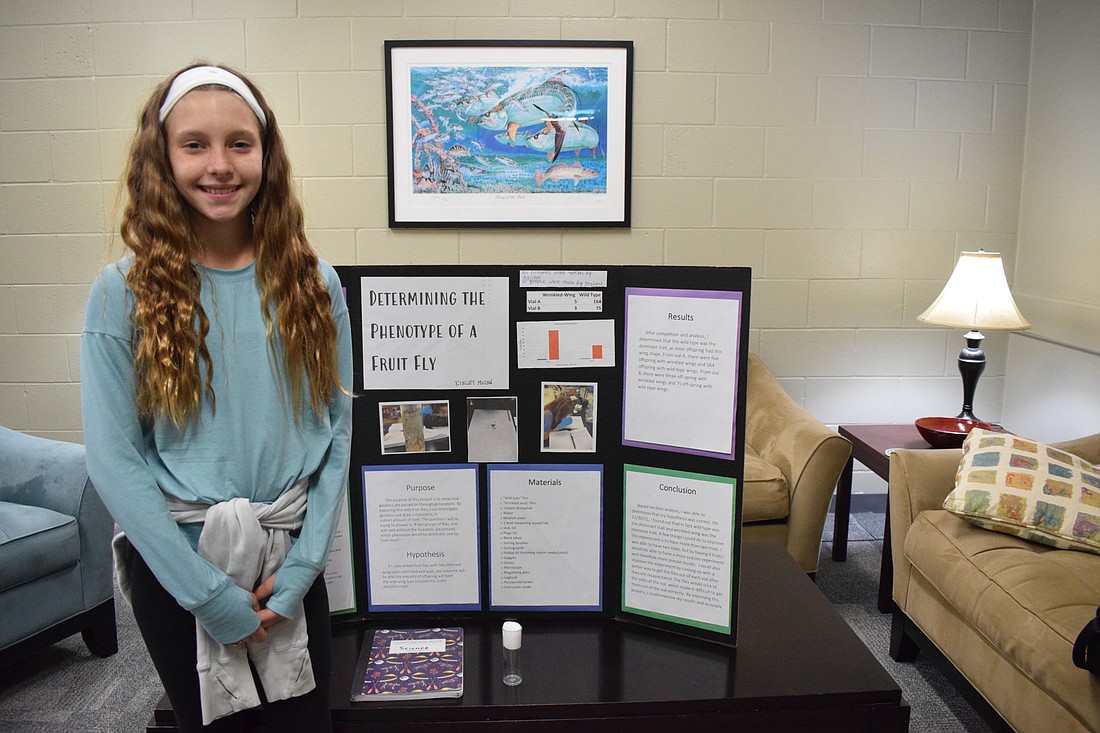- April 16, 2025
-
-
Loading

Loading

Gone are the days of making model volcanoes that explode.
East County science students now conduct various experiments from the study of fruit flies to the study of the speed of light in gelatin.
In pursuit of earning a trip to the 67th annual State Science and Engineering Fair in Lakeland, students were tasked with designing and conducting their own independent research following their scientific methods. Then they needed to prepare a presentation of their thesis to judges.
“It’s our job as a teacher to introduce them to the parts of science that they don’t know,” said Brittany Devlin, a science and engineering fair coordinator for the district and a science teacher at Dr. Mona Jain Middle School. “When you spark that interest, that’s where the true value of the research comes out because they can research something they actually care about as opposed to handing them a project I found on the internet.”
Twelve students from Dr. Mona Jain, Braden River and R. Dan Nolan middle schools are headed to the 67th annual State Science and Engineering Fair March 29-31 in Lakeland after seeing success at the School District of Manatee County’s fair.
A first place win at the district competition didn’t guarantee students advancement to the state competition. The judges selected which students would go on to compete at state.
“It’s a terrific opportunity for especially middle school students,” Devlin said. “They get to go to this fancy hotel and get to be so excited and enamored with not just competitive science but to feel like their research was valued. To hear from not just all the teachers who are supposed to say nice things but to hear someone from Yale come up to you and said, ‘I really liked what you did’ is validating.”
Here is a look at the different projects that are going to compete at the state competition.
McCaw, a sixth grader at Dr. Mona Jain Middle School, spent days surrounded by hundreds of fruit flies.
She chose to do a genetics project where she bred fruit flies to determine whether they would have a physical characteristic that was on a dominant or recessive gene.
McCaw had to work on her project after school in one of the science classrooms so she wouldn’t bring flies home.
Before studying each fly, McCaw used an anesthetic to put the flies to sleep. At that point, she had less than 20 minutes to study them before they would wake up.
McCaw took every tiny fly and used a magnifying glass to study them to see what type of wings they had.
“It was especially hard because they are such a tiny little organism,” she said. “You’re squinting your eyes to try to figure out what it is. I know the wings are pretty apparent but trying to figure out which gender they are based on the underside and the coloring was so hard because it’s the slightest tint that makes them different.”
McCaw wanted to challenge herself by picking a project with material covered in seventh grade.
“I just have a thirst for knowledge,” McCaw said. “Science has always come easier to me than any other subject.”
Perez, a Braden River Middle School seventh grader, decided to study how different angles would impact the speed of light in clear gelatin.
At first, Perez tried having his project focus on how different size gelatins would impact the speed of light, but after realizing he made errors in the calculations, he changed his approach.
“I know it’s important to double or triple check your work and make sure you have done the best you could,” Perez said.
Perez decided to use the same size gelatin but he changed the angles at which the laser hit the gelatin. Then he would figure out the angle of refraction.
Jennifer Hall, the science teacher helping students with the Science and Engineering Fair at Braden River Middle, was happy to hear Perez went back and adjusted his experiment.
“So often kids feel like if it’s not right the first time, they failed,” Hall said. “We hate that because in science that’s not how that works. If you make a mistake, and you can see your mistake and fix it, it’s going to help you do better science in the long run.”
Lander, a seventh grader at R. Dan Nolan Middle School, wanted to show the impacts of global warming.
With her experiment, Lander studied how various amounts of carbon dioxide affected the temperature of water.
“Global warming has always been something that concerns me, and doing this project helped me to prove global warming and its effect on the earth,” Lander said. “If we don’t fix things now then future generations will be harmed.”
Lander put different amounts of water into three water bottles and left another empty. She then submerged the bottles upside down in a large bucket of water. She removed the caps on the bottles to be able to insert carbon dioxide into the bottles using a carbon dioxide tank until the water from the bottle was gone. She put the cap back on the bottle while it remains under water and added a temperature probe. Lander then put the bottles under heat lamps and watched the temperature rise.
Lander found that the bottle with the most carbon dioxide, on average, caused the hottest temperature.
“I learned that to stop global warming, we should be using less carbon dioxide, fossil fuels and greenhouse gasses,” Lander said.
Lander was excited when she was announced as a first place winner.
“When I walked up to the stage, I had a huge smile on my face,” she said. “I could tell that all my hard work paid off.”